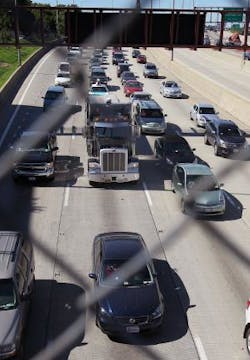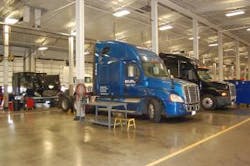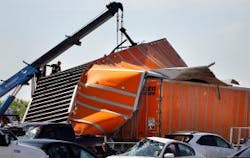The potential dangers drivers face day-in and day-out on the highway put every trucking business at risk. One misstep and years of hard work and profits can be wiped out. And with the growing dangers posed by online cyber criminals, fleets are now facing even more, and often hidden, dangers. That’s why insurance is one of those must-have items for anyone operating a commercial trucking business.
Crashes involving trucks and the resulting insurance claims can grab quite a chunk from the bottom line of any motor carrier. According to data compiled several years ago by the Federal Motor Carrier Safety Administration (FMCSA), the cost of a crash involving one Class 8 tractor pulling a single 53-ft. trailer runs to $172,292. If just one person gets injured in such a crash, the average cost balloons to $334,892. And if a fatality occurs in such a crash, the average cost skyrockets to over $7.6 million.
Yet despite such hefty dollar figures, there are still plenty of opportunities for trucking firms large and small to minimize insurance expenses, a bottom-line cost that global consulting firm Frost & Sullivan says makes up 4% of a fleet’s total cost of operation (TCO).
For starters, Bill Caudill, commercial auto product manager at Progressive Insurance, says there are several things carriers with strong safety records can do to help lower their insurance costs. The first step, he points out, is not to be shy about looking for discounts.
“Check what discounts you’re eligible for, and make sure you’re taking full advantage of everything that’s available,” Caudill stresses. “There are many kinds of discounts, including having three years of business experience and paying your policy in full. Ask your insurer or independent agent plenty of questions to ensure you’re getting the most for your money, especially if you have an excellent driving history.”
Second, request a policy review. “If you haven’t taken a close look at your policy recently, reach out to your agent or insurer about a policy review,” he emphasizes. “They can help you review your premiums and coverage to make sure that everything is up-to-date. Your truck value could come into play as well. As time goes by and you put more miles on your rig, the book value decreases and that could translate into savings.”
As the driver shortage is worsening, another tip coming into play is to lower insurance coverage on trucks that are in what he calls “temporary storage,” i.e., those units parked against the yard fence.
“If your truck goes into storage, consider moving it to a comprehensive-only policy,” Caudill says. “Think about it. When your truck is locked away, you don’t need collision coverage.
Comprehensive coverage will protect your truck from things like theft, vandalism and fire while it’s in storage, protecting your truck from the unexpected.”
This kind of switch also allows fleets to maintain continuous coverage on their equipment, which can help keep the overall insurance bill lower at policy renewal time. “And, yes, there’s often a discount for that, too,” he notes.
Fourth, look into payment plan options. “Some insurers have significant finance charges associated with their bill plans, or don’t have flexibility in payment schedules,” says Caudill. “Look for companies that offer flexible pay plans, including low initial payments and no finance charges. Rather than paying your policy premium in one annual payment or quarterly installments, you may be able to spread your premium over monthly payments, helping your insurance bill fall in line with your cash flow."
Help from technology
Brett Stalnaker, a product manager at Progressive, notes that the insurance industry as a whole is constantly getting better at measuring risk in the trucking industry as it accumulates more information about the trailers, cabs and types of accidents that occur.
“Improvements in technology let us better analyze that data [and the result is] a fairer and more accurate price for any given customer,” he explains. “And that’s what’s really important. I think if you ask the average driver, they’ll tell you they just want what’s fair and right. Our goal is to deliver on that, and be there in the event of an accident to get them back on the road quickly.”
One trend Progressive is seeing, especially among larger fleets, is an increased importance placed on people who specialize in managing risk. “It’s smart; accidents in this industry can cause major setbacks if you’re not prepared,” he says. “It’s their job to manage that risk and our job to get them back up and running as quickly as possible if they need us.”
That’s one reason why technology is becoming a bigger player in the trucking insurance game, albeit obliquely. A variety of systems are being positioned not just as safety enhancements for trucking firms but also as a way to gain insurance discounts as well.
Lytx Inc., for example, offers an in-cab system wired to capture both data and video of driver behavior. While many truck drivers may object to such Big Brother-style technology watching over them, there’s now a direct cost-saving benefit for the fleet as a result of a deal Lytx recently signed with Sentry Insurance.
Under the agreement, Sentry will pay what the two firms term a “significant portion” of the monthly program cost associated with Lytx’s DriveCam system while planning to make that system an “integrated component” of its loss control services.
“The DriveCam program will help our customers operate safer fleets and help us protect them against fraudulent claims,” notes Dave Gibson, Sentry’s director of transportation safety services. “We believe so strongly in the program that we’ll share a portion of our customer’s cost to implement the program.”
You can bet, too, that if a fleet’s drivers rack up good safety statistics that can be monitored via Lytx’s program, insurance discounts offering carriers a second potential avenue of savings might be available as well.
“There has been an increased focus on the utilization of video [in] providing deeper insight into risk and providing the ‘absolute truth’ of an event, along with a platform approach to working collaboratively to reduce risky driving performance,” explains Adam Kahn, senior director of marketing for SmartDrive. “Insurance companies are seeing an acceleration of customers deploying both safety and telematics solutions with very positive results reflected in the customer’s improved claims experience.
“Insurance companies also retain a big interest in the accuracy of ‘risk-scoring’ and root-cause behavior analytics that are predictive of driver collisions,” he continues. “We have seen several companies evolve their business model, effectively developing a closer working relationship/partnership with their fleet customers in order to reduce risk.”
Big data dig
Steve Bowden, director of Navman Wireless, stresses that just putting a telematics solution into a truck does not automatically create safer driving. “It may have some small influence, but what is needed to ensure the outcome is to put the right business rigor and policies around the technology and to have the right reporting suite and feature set to manage the poor driving behavior once identified,” he stressed.
But Bowden also points out that in order for a fleet to improve its ability to manage risk, it must be able to measure risk and then act on its findings. That includes tracking and correcting poor driver behavior, unauthorized vehicle use, fuel theft, and poor maintenance scheduling.
“The big trend will be in how to improve the collation and management of big data collected from a telematics system … to then improve performance of the fleet including major issues like poor driver behavior,” Bowden explains.
Yves Provencher, director of research company Performance Innovation Transport, notes that his firm uses telematics data to develop many correlations between fuel efficiency and safety, meaning that, based on measurable data, there are no doubts that a fuel-efficient driver is also a safer driver.
“Just think about hard braking,” he explains. “A driver that experiences much hard braking will consume more fuel, and chances are that this driver is also a ‘close follower’ of other vehicles; therefore, they are at higher risk for an accident. Considering that many trucks are equipped with telematics today, there is definitely an appetite to use telematics data to evaluate driver risks.”
Filtering data
Provencher adds that technology is there and the data is there, yet the challenge for many fleet managers—and eventually for insurance companies—is to find the time and the expertise to manage this information. “They have a lot of data but where do they start to look? How can they filter the exceptions? That is one of the challenges,” he says.
Progressive’s Stalnaker cautions that even though technology is rapidly gaining a role in helping reduce transportation industry risk analysis, it is still very early on in the lifecycle of what kind of information it can provide to help improve measurement of insurance risk.
“Many fleet managers are using it to better manage their fleets, which makes a lot of sense,” he says. “But in insurance, there is still a lot to learn about benefits and limitations, so while we would like to use it more often, we are still trying to assess how it can best be used.”
A trucking insurance tip sheet
For fleets seeking ways to reduce their insurance premiums without skimping on coverage, Progressive’s Brett Stalnaker offers a few tips:
- Don’t be afraid to ask your insurer or insurance agent for a policy review. This will help you make sure your truck value and premiums are current. You may need to adjust your coverage limits if the value of your truck changes.
- Regular policy reviews aren’t the only thing that will help lower costs. Regular maintenance helps you avoid equipment violations that could cost you an additional $300 to $2,000 in annual insurance premiums. Routine maintenance pays off long term.
- If you have multiple trucks, switch the ones in storage to a comprehensive-only policy. This also could apply to temporary downtime from being on the road. A comprehensive policy protects your truck from things like theft, vandalism and fire while it’s in storage. Note: Don’t cancel your policy completely in these instances, because most insurance companies give you a better rate if you have proof of continuous coverage. If you do cancel your policy, you’ll likely have a higher premium when you get insurance again.
Having the right coverage can help fleets save money in the event of the unexpected. For example, he notes, Progressive offers a wide range of truck-specific coverages tailored to business needs, including:
- Non-trucking liability coverage pays for damage to other people and their property if you drive your truck for personal use.
- Cargo insurance covers cargo damage or loss due to theft, fire, collision or even running over your own load. If cargo is refrigerated, consider a refrigeration breakdown endorsement to cover goods in the event that an accident affects the refrigeration system.
- Single deductible protects you if you’re in an accident that involves multiple “physical damage” deductibles. If you have multiple claims, you only pay one deductible instead of paying for each one individually.
- General liability (GL) insurance pays for injuries or property damage caused as a result of business activities not directly related to operating the truck. If cargo is delivered to the wrong location, for example, GL would cover it.
- Rental reimbursement with a “downtime” addendum provides “pay per day” for the time a truck is off the road. Additionally, Progressive helps fleets look for a reasonable replacement while a truck is out of service under such policies.
Measuring supply chain risks
As U.S. and Canadian businesses expand overseas, the risk potential of supply chain failures, data breaches and political instability are beginning to weigh more heavily on the minds of their executives, according to a survey conducted by the Chubb Group of Insurance Companies earlier this year. Three hundred senior executives were polled by JLA Strategic Research, an independent public opinion and market research firm.
The 2014 Chubb Multinational Risk Survey identified the top overseas business threat as supply chain failure (19%). A data breach/cyber event (15%) ranked second, and government/regulatory investigation and political instability were tied for third (13%). Natural catastrophe (12%) was ranked fourth out of the 10 events listed.
“Companies large and small continue to seek out new business opportunities abroad, and they increasingly are being confronted by political and economic turmoil, natural and man-made disasters, and regulatory hurdles,” notes Kathleen Ellis, senior vice president and worldwide manager for Chubb Multinational Solutions. “As they expand their international business operations, companies need to take a more holistic or global approach to managing risk.”
Nearly half (45%) of the executives surveyed noted that overseas risks pose a greater threat to their company than domestic ones, while one-third (33%) reported that overseas risks are an equal threat. In addition, nearly half (48%) of the companies had experienced at least one loss related to conducting business overseas over the last three years.
Yet despite their concern regarding supply chain failures, only 56% of companies in Chubb’s survey maintain a business continuity plan that addresses overseas risks, while 22% of companies that do have a plan say they have never tested it.
Larger companies (74%) were much more likely to be prepared for overseas business interruptions than smaller companies (48%), with 40% of respondents noting they require their overseas suppliers and vendors to have a business continuity plan.
“The lack of business continuity plans and testing is disturbing,” stresses Ellis. “Companies are left exposed to significant supply chain failures and associated business interruption costs that can undermine their financial results and stability. It is equally important for companies to assess whether their overseas suppliers and vendors also have up-to-date, well-tested business continuity plans.”
About the Author
Sean Kilcarr
Editor in Chief
Sean Kilcarr is a former longtime FleetOwner senior editor who wrote for the publication from 2000 to 2018. He served as editor-in-chief from 2017 to 2018.




